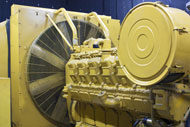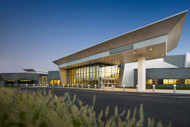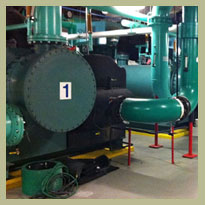
According to the Environmental Protection Agency (EPA), health care organizations spend nearly $8.8 billion annually on energy to meet patient needs. In a typical hospital, the biggest consumer of electrical power is the HVAC system, accounting for as much as 42 percent of total usage. The HVAC system and chiller plant alone can push a hospital's electric bills close to over a million dollars a year.
With the right peak performance strategy and technologies, it is possible to cut HVAC and central plant energy use by as much as 40 percent.
For instance, Broward Health Medical Center (BHMC), Fort Lauderdale, Fla., registered savings of over $250,000 in one year after implementing advanced analytics and optimization to provide visibility and transparency into the performance and service of its HVAC system and 6,000-ton chiller plant.
Six steps to savings
Because each hospital is unique, understanding HVAC as an integrated eco-system is important for achieving maximum efficiencies. Following are six steps a hospital can take to generate immediate and long-term energy cost savings:
1. Evaluate the system's current state. Everything begins with the documentation of the equipment and correlating specs. The efficiency of the chiller depends on the amount of energy or electrical current consumed for cooling, measured in kilowatt per ton (kW/ton).
The lower the kW/ton rating, the more efficient the system. While not everyone is using this criteria, it is generally the cleanest metric for measuring optimization, regardless of the type of equipment or power source.
Many management teams look at British thermal units (BTUs) per square foot as a key metric. However, if the system is not operating at peak efficiency, this metric fails to provide enough detail to help determine the problems.
When documenting any current issues or pain points with a system, health facilities professionals should take time to extend their thinking beyond the symptoms to what is causing them.
2. Develop realistic goals. Once health facilities professionals have a clear picture of your system's current performance, it's time to align common objectives with those of other stakeholders to target realistic goals. Facilities professionals will want to ensure that everyone involved in decision making, including operations, finance and administration, is in agreement. Health facilities professionals are looking for immediate and appropriate feedback to help them gain control of their buildings and ensure higher comfort levels. The focus is on controlling and lowering expenses.
It's easier to prioritize work orders and fixes if a software solution that provides a concise roadmap for energy conservation measures is used. There are some advanced solutions available, and the right technology tools can enable better articulation of opportunities with payback analysis, along with clear tracking and measurement of results.
Solutions that provide around-the-clock monitoring and interactive dashboards, provide building engineers and facilities managers with greater control and visibility over their sites. This helps improve troubleshooting and leads to better dialogue with your vendors and sub-contractors.
Lowering costs also must be balanced or coupled with maintaining comfort consistently throughout the building. Reducing energy consumption should be considered across a timeframe, not just one point in time. An investment that keeps the facility professional's hand on the heartbeat of the plant and the hospital's energy usage letting the professional know instantly how the system is running is well worth the expense. It can result in up to 40 percent energy cost savings with payback in 12 to 18 months.
BHMC reached payback within just 14 months. The hospital was able to identify and correct HVAC performance gaps almost immediately. With 85 percent of its building under automation, the hospital has attained superior energy efficiency with a 26-percent reduction in energy use and an enhanced kW/ton ratio of 1.5.
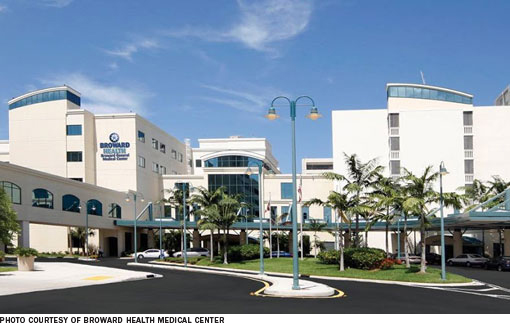 |
|---|
| The entrance to Broward Health Medical Center in Fort Lauderdale, Fla. |
3. Understand the data and feedback loop. Because a building automation system (BAS) is for static and theoretical sequences, it may not be able to give facilities professionals the advanced analytics needed to holistically optimize an HVAC plant. More advanced analytics can show how a system is operating, and then facilities managers can tweak building automation sequences to better optimize it, thus establishing a smart feedback loop.
For a more precise understanding of data and feedback, facilities professionals should ask "What is the most appropriate data for our goals and why it is important?" "To capture the feedback we want, how often should the data be collected?" and "Are all sensors and meters calibrated and working properly?"
4. Present data as an action plan. Data is only valuable if it can be acted on for results. Because it's tempting and easy to overload on information, a "Plan -- Do -- Check -- Act" approach works best.
While a traditional BMS presents data, many times it can be too much and overwhelming. This data can be ignored, which often happens due to an overload of alerts, alarms and notifications, or building analytics can be implemented to enable facilities managers to digest the data, analyze it and take intelligent and actionable steps that lead to optimization.
The captured information will help build a business case for efficiency, supporting all decisions regarding changes to the HVAC system and chiller plant.
5. Stabilize current operations. Constant monitoring provides complete transparency to ensure that systems are running properly. It immediately notifies operations when something is wrong, rather than waiting until the next commissioning, which could be a year or longer. Over the course of 12 months, equipment ages and degrades and other variables can impact systems. Additionally, unusual weather conditions can occur along with a multitude of other factors that can strain or change the operational integrity of a plant.
The most important benefit of constant commissioning is the visibility of efficiency or inefficiency on specific pieces of equipment. Continuous monitoring ensures that a plant's true performance is in line with its original design standards. This type of tracking allows you to conduct cost-saving analysis and to adjust components as needed in order to maintain optimal energy efficiency.
Because the plant is a dynamic environment, issues are constantly occurring. In today's economy, few hospitals have extra facility workers, so they must focus on the most important faults. A system should be able to prioritize those faults. At Broward Health, 70 percent of all calls to the help desk center are from individuals complaining that they are too hot or too cold. A proper feedback loop could identify root causes quickly and allow employees to focus on proactive, preventive work rather than on reactive control issues.
Once a constant commissioning program is in place, facilities professionals also can ensure that all repair work improves efficiency. For example, by leveraging constant commissioning, Miami Children's Hospital was able to uncover serious inefficiencies in its plant that it then brought to vendors to address. The objective is to develop a "fix forever" mentality.
By stabilizing first, health facilities professionals can avoid spending money unnecessarily and they can expect to yield long-term savings. Efficiencies and savings are already "latent" with a current HVAC system, waiting to be discovered.
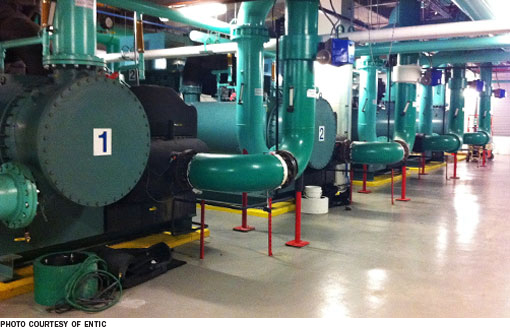 |
|---|
| A portion of Broward Health Medical Center's central plant. |
6. Find the peak. Once the system is stabilized, it's time to find its peak performance. This is easier to accomplish if achieving the peak is viewed not as an expense, but as an investment that delivers energy savings. The organization has made a substantial investment in the chiller plant and other HVAC components. Perfecting and protecting that equipment requires an investment mindset as well.
Regardless of the age of the system, health facilities professionals can start conserving energy right away by maximizing what they already have in place. They need to identify the key equipment, implement setpoint adherence and then commit to preventive maintenance. By closely watching usage trends in this key equipment, you will be able to determine problems before they happen. We call this predictive maintenance. This methodology will enable you to analyze data in order to better model improvements and track actual cost savings, supporting your investment.
Now, you are ready to drive your system to further peak performance by applying optimization science for around-the-clock predictive maintenance. New technologies can automatically direct your HVAC system to efficiencies not otherwise possible with conventional sequencing.
Moving into the new era
The types of inefficiencies uncovered at BHMC are often found in health facilities and other commercial and industrial buildings, especially as they begin to implement analytics and gain insight into the operations of their plants. By moving a health care facility into the new era of HVAC and central plant peak performance, health facilities professionals can expect to see total energy consumption drop significantly resulting in savings of up to 40 percent.
Manny Rosendo is cofounder and CEO of Entic, a Miami, Fla.-based specialist in HVAC and central plant performance. He can be reached at mrosendo@enticusa.com.




